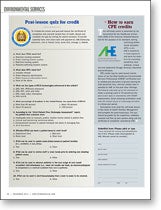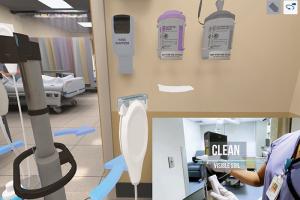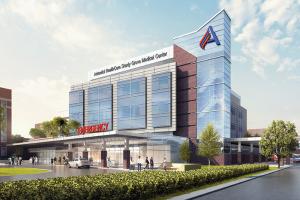Easing patient flow
 From overcrowding in the emergency department (ED) waiting room to federal mandates to reduce patient wait times, patient flow is on everyone's mind.
From overcrowding in the emergency department (ED) waiting room to federal mandates to reduce patient wait times, patient flow is on everyone's mind.
Moreover, as the scrutiny around patient flow has intensified, so have the proposed solutions to promote throughput and reduce bottlenecks, which make it difficult for organizations to know where to begin.
Multifaceted process
Patient flow is a multifaceted process that can be continually enhanced at the process, departmental and enterprise level, and the environmental services (ES) department can be one of the most optimal channels for promoting efficiencies.
ES can affect patient throughput and capacity to promote patient care, and significant improvements can be delivered through visibility — monitoring movement of patients, staff, visitors and equipment in real-time.
Knowing the exact location of assets, resources, staff and patients is key to moving the patient through treatment with the most efficient and effective outcomes. Realizing this, many hospitals in the United States today utilize some form of real-time locating system (RTLS). These systems track and identify the location of objects by using badges or tags attached to the objects, which transmit signals to wireless sensors to determine their locations.
Used at varying degrees by more than 60 percent of U.S. hospitals, real-time locating systems have been proven to reduce wait times — a key element to positive patient perceptions. With strategic implementation, these locating systems directly enhance every aspect of patient flow, from alerting staff when a patient is ready to be seen to documenting patient alone time for quality improvement.
The entire organization can operate efficiently when each individual knows exactly what has been done and what needs to be done to advance the patient to the next stage of care. In addition to faster throughput, the result is safer and more effective patient care.
Top concerns
To measure the industry pulse on patient flow, the American Hospital Association's AHA Solutions Inc. completed a research study last year titled the "2010 Patient Flow Challenges Assessment" (www.aha-solutions.org/what/pfca.shtml). The report identifies eight key stages of patient flow that hold potential for improvements, including preadmissions, admissions, diagnostic, procedure, recovery, discharge, post-discharge and home.
Findings from the report indicate that respondents consistently were most concerned at each stage about patient handoffs. Inefficient or inadequate patient handoffs are a persistent problem and probably indicative of enterprisewide communication and technology system limitations.
This clearly was reflected in the top concerns cited by study participants, which ranged across all stages of patient flow and included the following:
- Inadequate tools to measure, predict and monitor events critical to patient flow;
- Clinical staff performing nonclinical duties;
- ES or patient transport staff not active in managing flow;
- Ability to have bed cleaned by ES immediately;
- Availability of transport and ES staff;
- Lack of real-time bed visibility for true bed availability;
- Searches for staff, doctors or equipment;
- Availability of staff to perform procedures (including room turnover);
- Availability or proximity of equipment, supplies and medications.
Clearly, improving the ability to access and share patient information would mitigate many worries about patient flow. The leading enterprisewide constraints reported by respondents all relate to data accessibility. The inability to capture data accurately and the requirement for patients to provide data multiple times are leading constraints, topped only by the challenge of staying signed on to workstations.
Addressing the concerns
An RTLS addresses these concerns by improving the ability to capture, communicate and share patient data accurately, which promotes improved communication throughout the enterprise.
Effective locating systems help protect patients and staff by monitoring movement of patients, staff, visitors and equipment in real time to detect instantly their whereabouts and analyze historical movement. So, organizations can monitor interactions among people, equipment and their locations for patient status, staff availability and location, and inventory management.
Using infrared (IR) technology, the system precisely determines the location of patients, staff, visitors, equipment, charts and other assets tagged with badges. Next, the software platform captures and transmits the location data directly to information systems to manage resources, services and processes.
Departments then use the electronic boards to monitor patient flow, assets and resources. Finally, enterprises use the reporting and analytics data from the real-time locating systems for compliance, documentation and measurement.
RTLS solutions are effective in managing Joint Commission Environment of Care standards, including reporting problems, failures and user errors related to medical equipment, and evaluation of the medical equipment management plan.
For superior performance, health facilities also will want to confirm that the solution offers clinical-quality data and locating metrics. The solution should take the data and populate it into the organization's electronic health record and other systems, to deliver automation, documentation, reporting and measurement.
RTLS in the real world
While discussions about how an RTLS solution works can be illustrative, the best evidence is provided by real-world applications, such as the following:
Virginia Mason Kirkland (Wash.) Clinic. As indicated in the "2010 Patient Flow Challenges Assessment," the process of patient handoff was a top concern for ensuring flow. Virginia Mason Kirkland Clinic addressed this issue with an RTLS and achieved notable results.
While finalizing plans for its new facility, the clinic set out to reduce patient waiting times and improve satisfaction for patients and staff. Key to the team's success was to identify visually where patients waited and use that information to improve workflow processes.
"Understanding where our patients wait was always critical to creating a seamless, value-added experience, but we didn't have a good system to track and measure time," says Diane Owen, clinic director at Virginia Mason Kirkland. "We needed to track the patient's experience from check-in to departure and every step along the way. We needed to know when delays happened and why so we could make changes."
The organization chose an RTLS solution that utilizes a combination of invisible IR light and radio frequency identification (RFID).
This combination of IR and RFID provides the most finite locating capabilities available to health care. An RTLS solution built on these technologies could track individual patients at the department level, the bed level and even the chair level for surgical and clinical settings.
The clinic used the system to track room status (clean, dirty, patient-occupied), patient status (an onscreen figure identified the location of all people in the building), patient wait times (available on list views), provider status and even mobile equipment location.
Today, Virginia Mason Kirkland Clinic's patient satisfaction scores are some of the best in the region, in part because patients are waiting less; however, time with the provider is not compromised. The team attributes this to improvements in flow, the new clinic environment and its RTLS.
Memorial Hospital Miramar (Fla.). A key aspect to an RTLS is that it helps identify a room as clean, occupied, dirty and cleaning in process. Currently, the typical hospital has no automated notification procedure following patient discharge. Room cleaning can occur at any time, even sporadically, during the four hours between when a patient leaves the room and clean room confirmation.
Quicker room turnover provides more efficient throughput facilitywide, reducing boarding and patient bottlenecks. Looking to gain these advantages, Memorial Hospital Miramar investigated bed management applications and found the options to be very expensive.
Realizing many of the same functions they required were already being delivered by their existing RTLS asset and patient locating solution, the hospital
contacted the vendor for assistance. The vendor was able to provide additional automated bed management updates in real time using the same RTLS infrastructure and impressive results were noted by the hospital's staff.
In some hospitals, room turnover takes as long as 4-8 hours. At Memorial Miramar, the average time from patient discharge to clean room status was documented at 1 hour and 8 minutes.
Today, the average time to clean a patient room at Miramar is 24.6 minutes, faster than even high-end hotel standards. In addition, Miramar now is able to run its turnover report in less than 30 seconds using its RTLS report package.
When Memorial Miramar first implemented its new bed-turnover process, it worked so well that the ES staff were coming to clean the room even before transport volunteers had arrived to see the patient out.
The staff then revised the process so that transport volunteers are now responsible for placing the patient's RTLS badge in the discharge cabinet when they come to retrieve the patient, automatically alerting ES that the room is vacated and ready for cleaning.
Two root causes
In evaluating patient flow challenges, it appears that all the stages are actually elements of a continuous process with patient outcomes at its core. Two root causes of the challenges impacting patient flow are found in data visibility and communication.
When using a real-time locating system to address patient flow throughout an entire facility, health care professionals should confirm that the solution accurately accomplishes the following tasks:
- Reliably updates room status based on patient location (available, in use, dirty).
- Alerts the ES department that a room is ready to be cleaned.
- Advances patients to the next stage of care based on patient visit milestones and reminds staff to wash hands prior to entering and cleaning patient rooms.
- Locates equipment due for maintenance, testing or inspection.
- Automatically documents these details and other interactions and provides reports with a moment's notice.
- Provides reports for analytics and measurement to continually refine and strengthen processes and allows for system updates to support process enhancements easily.
Barry Cobbley is director of location solutions for Versus Technology Inc. in Traverse City, Mich. He can be contacted via his email address at bsc@versustech.com.
About this seriesThis bimonthly self-study series is a joint project of the Association for the Healthcare Environment and Health Facilities Management. Information on obtaining continuing professional education credit can be found here. |  |
| Click above image for quiz. |




